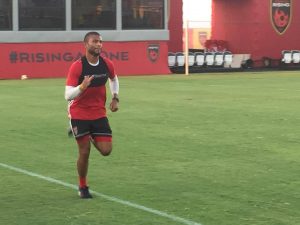- Slug: Sports-Rising technology, 790 words
- Photo available
By ERIC NEWMAN
Cronkite News
TEMPE — After suffering a right groin injury, Matthew Watson’s recovery was accelerated by learning he favored his left leg during competition. How did the Phoenix Rising FC defender find out?
His wireless half-shirt, equipped with GPS, told him.
As technological advances have become an integral part of professional athletic training, the Rising have utilized electronics in helping to prevent and recover from injuries and fatigue in a long United Soccer League season.
Watson said the built-in gyroscope in his STATSPort Viper was essential in his recovery. The tool sensed he was using one side more than other and the data accelerated the healing process.
“They’ve kind of measured me against what I’ve done in my last game to help and see how I’ve recovered in ground covered, my top speed, my balance,” Watson said.
An observer at Phoenix Rising practice can see players training in the wireless attire, which also include an accelerometer, gyroscope, heart rate monitors and more. It collects as much data as possible in training and matches, all of which is stored in a computer accessible to the team.
The data serves to not only track statistics over time, but also provides graphics for coaches to track players’ positions on the field and movements in real time from a computer or TV monitor.
The systems, which the website says are used by over half of the teams in Europe’s Champions League, still have not fully immersed themselves into soccer all over the world. Rising midfielder Kevon Lambert, who played for Jamaica in the CONCACAF Gold Cup this summer, said that even his international team rarely used training data in a run to the tournament’s final.
The data provides Phoenix, which is currently fighting for a spot in the USL playoffs, a step up on the competition with vast information for coaches and training staff to use.
“Any GPS system’s goal is to monitor or quantify the overall workload of training and games, and be able to establish a norm for what we need them to be able to do specific days,” athletic trainer Brennen Hodge said.
Hodge and the rest of the training staff said they build individual profiles for the players based on positions and their roles on the team. The staff knows that just like each player is in a different level of shape, they have different responsibilities that require various movements on the pitch.
The goal is not necessarily to make the players work harder than any other team, but rather to work smarter. The staff wants to keep conditioning up, while not overworking the players so they are not ready come game day to play at their best, and the technology helps to add more information into that equation.
“Right now we play a very organized defensive game with a fast counterattack, and so we know our outside backs and wingers are going to need to make very long, fast, 40-yard plus sprints,” he said. “So we know in training that we need to be able to maintain that ability.”
Coach Patrice Carteron said that data has even been used in part to assign starting roles and playing time throughout the year.
“Sometimes when we have the choice between two players, if you feel like right now one player is ready to give 100 percent, he is running much more on the field than his friend, it can help you to decide,” Carteron said.
The one thing, however, that cannot get lost in the innovation is the human aspect of the game, and no amount of technology can truly measure just how an athlete is feeling.
Though he has have become accustomed to suggestions from trainers, Watson got to a high enough level to play professional soccer by playing as hard as possible, and it is not always easy to hear that it might be time to take a break or sit out for some of training.
“I want to run my hardest every day regardless of the numbers, but that’s just me,” Watson said. “I use it as a mark for my fitness, but when I get into the game I don’t think about it, I’m just playing football.”
What the Viper systems do then, are provide another tool at the disposal of the Rising’s coaches to have players ready come match day.
Carteron and the staff know that what matters is the result at the end of the match, but Vipers have made the work to get there just a bit easier.
“Football is a technical game. We do the best for the players to be ready physically, but after this, tactical work is also very important. But it’s interesting for us to have all this information,” he said.
